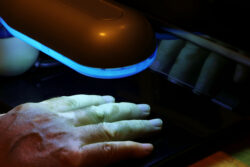
Can White People Have Vitiligo?
Vitiligo is a skin condition that causes the loss of pigment, resulting in white patches on various parts of the body. It affects people of all skin tones, races, and ethnic backgrounds. However, a common question that many people ask is: Can white people have vitiligo? The short and simple answer is yes, white people can and do get vitiligo.
In this blog, we’ll take a closer look at what vitiligo is, how it affects individuals of different skin colors, including white people, and clear up any misconceptions about this condition.
What Is Vitiligo?
Vitiligo is a long-term skin condition in which the skin loses its pigment, known as melanin. Melanin is what gives skin, hair, and eyes their color. When the cells responsible for producing melanin (called melanocytes) are destroyed or stop working, white patches of skin appear. These patches can occur on any part of the body, including the face, hands, arms, feet, and even inside the mouth.
Vitiligo is not contagious or life-threatening, but it can have a significant emotional and psychological impact on those who have it.
Can White People Have Vitiligo?
Yes, white people can have vitiligo just like people with darker skin tones. The condition does not discriminate based on race or ethnicity. It affects approximately 0.5% to 2% of the global population, and that includes people with fair or pale skin.
While the contrast between normal and depigmented skin might be less noticeable in lighter-skinned individuals, the loss of pigment still occurs, and the condition is still very real. In fact, it may be harder to detect in white people, especially during the winter months or in areas of the body that are not frequently exposed to the sun.

Why Is Vitiligo Less Noticeable in White People?
One reason people may mistakenly think that white people can’t have vitiligo is that the symptoms are sometimes less visible. For those with light skin, the white patches caused by vitiligo may blend in with the natural skin tone, particularly if the person avoids tanning or sun exposure.
However, this doesn’t mean that the condition isn’t present. In some cases, a white person might not even notice they have vitiligo until they tan and the contrast between the pigmented and depigmented areas becomes more apparent.
It’s also worth noting that other symptoms, such as premature graying of hair, changes in eye color, or changes in the color of the retina, can also be signs of vitiligo, even if the skin patches are hard to see.
Causes of Vitiligo
The exact cause of vitiligo is not fully understood, but several factors are believed to contribute:
- Autoimmune response: The immune system mistakenly attacks and destroys melanocytes.
- Genetic factors: Family history of vitiligo or other autoimmune conditions can increase risk.
- Environmental triggers: Stress, sunburn, or exposure to certain chemicals may trigger the condition.
- Oxidative stress: Imbalance of antioxidants and free radicals in the body might play a role.
Again, these causes apply to all individuals, whether they have dark skin or light skin. So if you’re wondering can white people have vitiligo due to different genetic or biological factors, the answer remains yes.
How Is Vitiligo Diagnosed in White People?
In people with darker skin, vitiligo patches can appear as stark, contrasting areas of white. But in white people, the diagnosis can be trickier. Doctors might use a special light called a Wood’s lamp, which helps highlight areas of pigment loss that might not be visible to the naked eye. This tool is helpful in identifying early signs of vitiligo in individuals with pale or fair skin.
A dermatologist may also take a skin biopsy or run blood tests to check for autoimmune issues or thyroid conditions, which are sometimes linked to vitiligo.
Treatment Options
There is currently no cure for vitiligo, but several treatments can help improve the appearance of the skin:
- Topical corticosteroids: These creams can help restore some pigment, especially if started early.
- Light therapy (phototherapy): Narrowband UVB treatment can stimulate melanocytes.
- Topical calcineurin inhibitors: Helpful in sensitive areas like the face or neck.
- Depigmentation therapy: For those with widespread vitiligo, this involves lightening the remaining pigmented areas.
- Cosmetic cover-ups: Makeup or self-tanning products can help even out skin tone.
For white individuals, the choice of treatment might depend more on how visible the patches are and how much they personally affect self-image or emotional health. Since the contrast in skin tone might be minimal, some white people with vitiligo may choose not to pursue treatment at all.

Emotional and Psychological Impact of Vitiligo
Even though vitiligo is not harmful to the body physically, it can have a major impact on a person’s mental and emotional well-being. This is true for people of all races. However, since vitiligo is less visible in white people, others might not understand why someone with the condition feels self-conscious or upset.
Comments like “I can’t even see it” or “You’re lucky it doesn’t show” can feel invalidating to someone who is dealing with the stress of a chronic condition. That’s why it’s important to recognize that vitiligo, regardless of skin color, is a valid medical issue that deserves understanding and support.
Support groups, counseling, and awareness campaigns can all help reduce stigma and build a sense of community for people living with vitiligo.
Famous White People with Vitiligo
Although most public figures with vitiligo are more well-known in communities of color (like model Winnie Harlow), there are also white celebrities who have spoken openly about having the condition. For example, actor Jon Hamm reportedly has a mild form of vitiligo on his hands due to stress.
These public examples help prove the point: yes, white people can have vitiligo, and they do. The more people who talk about it, the more we can reduce the stigma and increase understanding of the condition.
Common Myths Debunked
Let’s take a moment to address a few common myths:
Myth 1: Vitiligo only affects people with dark skin.
Truth: It affects all races, including white people.
Myth 2: White people can’t notice vitiligo.
Truth: While it may be less visible, it’s still there and can be diagnosed by a doctor.
Myth 3: Vitiligo is contagious.
Truth: Vitiligo is not contagious. You can’t catch it from touching someone.
Myth 4: Vitiligo is caused by poor hygiene.
Truth: It has nothing to do with cleanliness. It’s a medical condition often linked to autoimmune responses.
Can Vitiligo Be Prevented?
Currently, there is no guaranteed way to prevent vitiligo. Because the exact cause is still not fully understood, though it’s believed to be linked to autoimmune issues, genetics, and environmental triggers, doctors haven’t identified a clear prevention strategy.
However, certain habits may help support overall skin health and possibly reduce your risk of triggering pigment loss, especially if you have a family history of vitiligo or other autoimmune conditions:
1. Protect Your Skin from Sunburn
Sunburn can sometimes trigger or worsen vitiligo patches. Always use sunscreen with at least SPF 30, wear protective clothing, and avoid long exposure to the sun during peak hours.
2. Manage Stress
While stress doesn’t directly cause vitiligo, it may contribute to flare-ups or progression in some people. Practicing relaxation techniques like yoga, meditation, or deep breathing exercises can help manage daily stress.
3. Eat a Healthy, Balanced Diet
A diet rich in antioxidants, vitamins, and minerals may help support immune health. Some people also explore anti-inflammatory diets to promote skin balance, though more research is needed.
4. Avoid Skin Trauma
Repeated skin injuries or friction (like frequent scratching, cuts, or burns) may sometimes trigger new vitiligo patches in a process known as the Koebner phenomenon. Be gentle with your skin and treat injuries promptly.
5. Regular Checkups
If you notice any unusual changes in your skin or have a family history of autoimmune diseases, visit a dermatologist early. Early diagnosis allows for more treatment options and better management.

Conclusion
So, to revisit our main question: Can white people have vitiligo? Absolutely. Vitiligo does not choose its host based on skin color. While it might be more visually striking on darker skin tones, it still affects many white individuals who experience the same emotional, physical, and psychological effects of the condition.
Understanding that vitiligo is a universal condition helps break down racial stereotypes and improves medical and social support for everyone living with it. Whether visible or not, the experiences of those with vitiligo, white or not, are valid and worth acknowledging.
If you or someone you know suspects they might have vitiligo, consult with a dermatologist. Early diagnosis and support can make a big difference.
